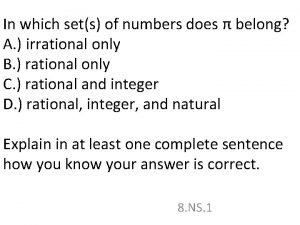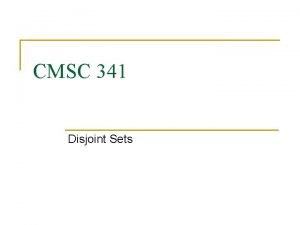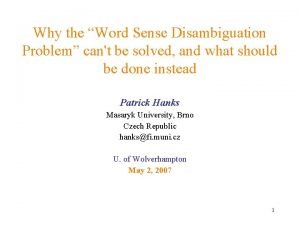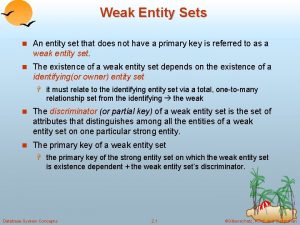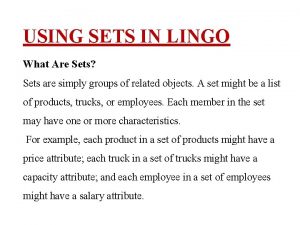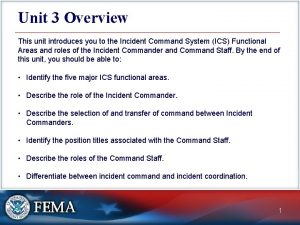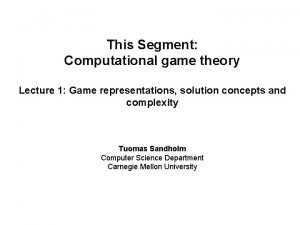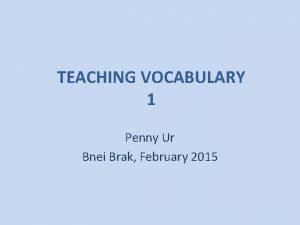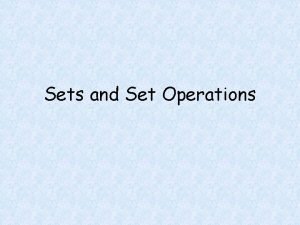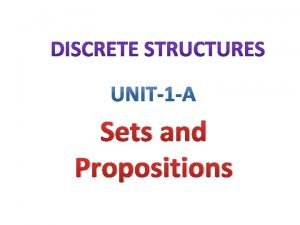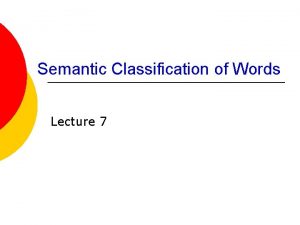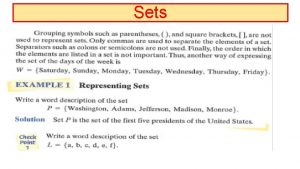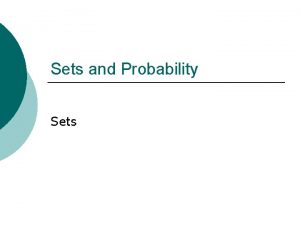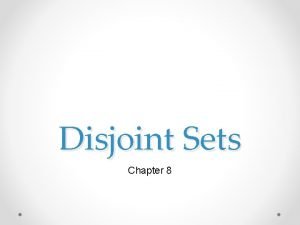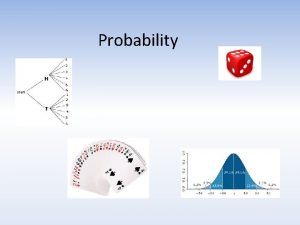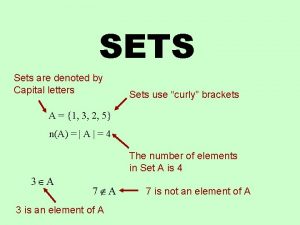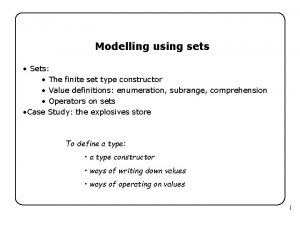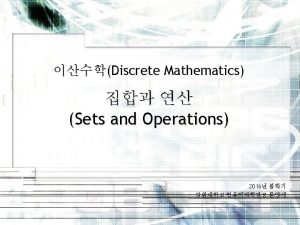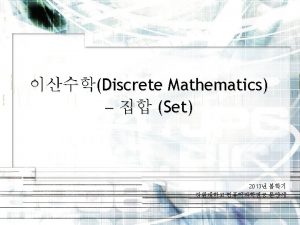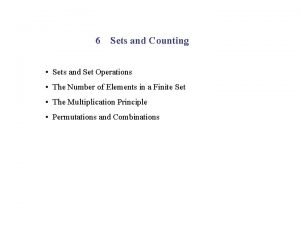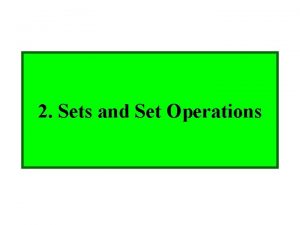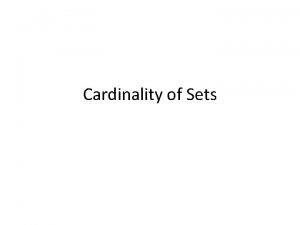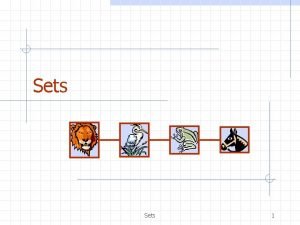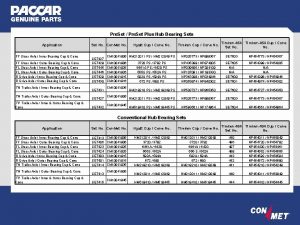2 1 Sets DEFINITION 1 A set is




















- Slides: 20

2. 1 Sets

DEFINITION 1 A set is an unordered collection of objects. DEFINITION 2 The objects in a set are called the elements, or members, of the set. A set is said to contain its elements.

EXAMPLE 2 The set O of odd positive integers less than 1 0 can be expressed by 0 , = { l , 3 , 5 , 7, 9}. Set builder notation: • the set 0 of all odd positive integers less than 1 0 can be written as o = {x I x is an odd positive integer less than 1 O} , or, specifying the universe as the set o f positive integers, as o = {x ε Z+ I x is odd and x < 1 O }. • the set Q+ of all positive rational numbers can be written as Q+ = {x ε R I x = p / q , for some positive integers p and q }.

Some Important Sets • N = {O, 1 , 2, 3 , . . . } , the set of natural numbers • Z = {. . . , -2, - 1 , 0, 1 , 2, . . . } , the set of integers • z+ = { I , 2, 3, . . . } , the set of positive integers • Q = {p/q | p ε Z, q ε Z, and q ≠ 0 } , the set of rational numbers • R, the set of real numbers.

DEFINITION 3 Two sets are equal if and only if they have the same elements. That is, if A and B are sets, then A and B are equal if and only if We write A = B if A and B are equal sets. EXAMPLE 6 The sets { l , 3 , 5 } and { 3 , 5 , I } are equal, because they have the same elements. Remarks: • Note that the order in which the elements of a set are listed does not matter. Note also that it does not matter • if an element of a set is listed more than once, so { I , 3 , 3 , 5 , 5 } is the same as the set { l , 3 , 5 } because they have the same elements.

DEFINITION 4 THEOREM 1

DEFINITION 5 Let S be a set. If there are exactly n distinct elements in S where n is a nonnegative integer, we say that S is a finite set and that n is the cardinality of S. The cardinality of S is denoted by I S I.

EXAMPLE 9 Let A be the set of odd positive integers less than 1 0. Then I A I = 5. EXAMPLE 10 Let S be the set of letters in the English alphabet. Then l S I = 26.

DEFINITION 6 A set is said to be infinite if it is not finite. EXAMPLE 12 The set of positive integers is infinite.

The Power Set DEFINITION 7 Given a set S, the power set of S is the set of all subsets of the set S. The power set of S is denoted by P(S). EXAMPLE 13 What is the power set of the set to, 1 , 2} ?

Solution: • The power set P ({ 0, I , 2 }) is the set of all subsets of {0, 1 , 2 }. Hence, • P ({0, 1 , 2 }) = {Ф, { 0 } , { l } , {2 } , {0, 1 } , {0, 2} , { l , 2 } , {0, 1 , 2 } }. • Note that the empty set and the set itself are members of this set of subsets.

Remark: If a set has n elements, then its power set has 2 n elements.

Cartesian Products DEFINITION 8 The ordered n-tuple (a. I , a 2 , . . . , an) is the ordered collection that has al as its first element, a 2 as its second element, . . . , and an as its nth element.

Equality of two ordered n-tuples We say that two ordered n -tuples are equal if and only if each corresponding pair of their elements is equal. • In other words, (a. I , a 2 , . . . , an ) = (bl , b 2 , • , bn ) if and only if ai = bi , for i = 1 , 2, . . . , n. • In particular, 2 -tuples are called ordered pairs. The ordered pairs (a, b) and (c, d) are equal if and only if a =c and b = d. • Note that (a, b) and (b, a) are not equal unless a = b.

The Cartesian product of two sets DEFINITION 9 Let A and B be sets. The Cartesian product of A and B, denoted by A x B, is the set of all ordered pairs (a, b), where a ϵ A and b ϵ B. Hence, A x B = {(a , b) | a ϵ A ᴧ b ϵ B }.

EXAMPLE 16 What is the Cartesian product of A = { I , 2} and B= {a , b, c}? Solution: The Cartesian product A x B is A x B = { (1, a), (1, b) , (1, c), (2, a), (2, b) , (2, c)}.

Caution! The Cartesian products A x B and B x A are not equal, unless A = 0 or B : : ; : : 0 (so that A x B = 0) or A = B

The Cartesian product of sets DEFINITION 10 The Cartesian product of the sets A 1, A 2 , . . . , An , denoted by A 1 x A 2 X • • • x An , is the set of ordered n-tuples (a 1, a 2 , . . . , an ), where aj belongs to Aj for i =1 , 2 , . . . , n. • In other words A 1 X A 2 x · · · x An = {a 1 , a 2 , . . . , an ) | aj ϵ Ai for i=1 , 2, . . . , n }.

EXAMPLE 18 What is the Cartesian product A x B x C , where A = {0, 1 }, B = { 1 , 2}, and C = {0, 1 , 2}? Solution: The Cartesian product A x B x C consists of all ordered triples (a , b, c), where aϵ A, b ϵ B, and c ϵ C. Hence, A x B x C = {(0 , 1, 0), (0, 1, 1), (0, 1, 2), (0, 2 , 0), (0, 2, 1) , (0, 2, 2), ( 1 , 0), ( 1 , 1 ), (1, 1, 2), (1, 2, 0), (1, 2, 1) , (1, 2, 2)}

Homework Page 119: • 1 (a, b) • 2(a) • 4 • 5(a, b, c, d, f) • 7(a, b, d, f) • 9
 Total set awareness set consideration set
Total set awareness set consideration set Training set validation set test set
Training set validation set test set In which set does −173 belong?
In which set does −173 belong? Disjoint set definition and example
Disjoint set definition and example Bounded set vs centered set
Bounded set vs centered set Fuzzy theory
Fuzzy theory Crisp set vs fuzzy set
Crisp set vs fuzzy set Crisp set vs fuzzy set
Crisp set vs fuzzy set What is the overlap of data set 1 and data set 2?
What is the overlap of data set 1 and data set 2? Correspondence function examples
Correspondence function examples Shape with 2 sets of parallel sides
Shape with 2 sets of parallel sides Lexical sets
Lexical sets Weak entity sets
Weak entity sets Lingo model
Lingo model Scenario the deputy incident commander will be replacing
Scenario the deputy incident commander will be replacing Information sets in game theory
Information sets in game theory Lexical sets
Lexical sets Even numbers symbol
Even numbers symbol Sets and propositions in discrete mathematics
Sets and propositions in discrete mathematics Lassification
Lassification These are predefined sets of different shapes
These are predefined sets of different shapes


